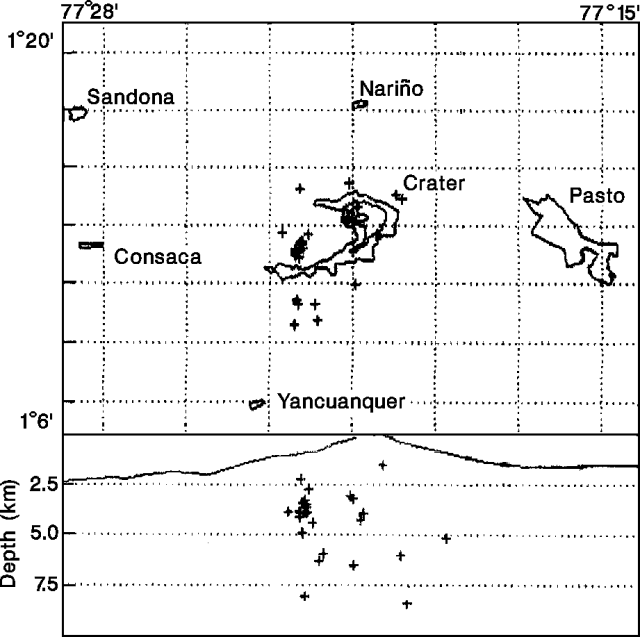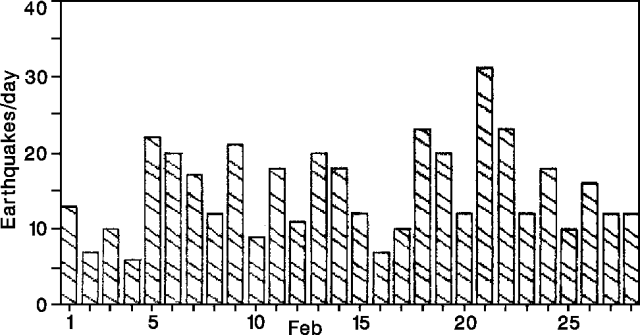Report on Galeras (Colombia) — February 1991
Bulletin of the Global Volcanism Network, vol. 16, no. 2 (February 1991)
Managing Editor: Lindsay McClelland.
Galeras (Colombia) Ash emissions and incandescence; more frequent earthquakes
Please cite this report as:
Global Volcanism Program, 1991. Report on Galeras (Colombia) (McClelland, L., ed.). Bulletin of the Global Volcanism Network, 16:2. Smithsonian Institution. https://doi.org/10.5479/si.GVP.BGVN199102-351080
Galeras
Colombia
1.22°N, 77.37°W; summit elev. 4276 m
All times are local (unless otherwise noted)
Three ash emissions and an increase in the level of incandescence were reported during February (table 4). Temperatures measured at Besolima fissure oscillated between 521 and 538°C (down from 738°C during January), while Las Deformes fumarole field had a maximum temperature of 262°C (similar to January, 250-265°C). SO2 fluxes, measured by COSPEC the last 4 days of the month, showed a steady decrease from 1,342 t/d (25 February) to 275 t/d (28 February).
Table 4. Reported activity and associated seismicity at Galeras, February 1991. Courtesy of INGEOMINAS.
| Date | Activity | Associated seismicity/duration |
| 10 Feb 1991 | Incandescence | -- |
| 10 Feb 1991 | Ash emission | Long-period / 40 seconds |
| 14 Feb 1991 | Ash emission and high noise level | Tremor / 100 seconds |
| 18 Feb 1991 | Ash emission | Long-period / 50 seconds |
| 19 Feb 1991 | Incandescence | -- |
| 21 Feb 1991 | Incandescence | -- |
During February, 42 high-frequency earthquakes were recorded, of which 27 were M 1.1-2.3. The earthquakes were centered on the W flank of the volcano (figure 33). The number of low-frequency earthquakes (figure 34) increased 45% compared to January. Long-period seismicity remained at moderate levels, similar to the last half of January.
 |
Figure 33. Epicenter map (top) and E-W cross-section showing focal depths (bottom) of 27 high-frequency earthquakes recorded at Galeras, February 1991. Courtesy of INGEOMINAS. |
 |
Figure 34. Daily number of low-frequency earthquakes recorded at Galeras, February 1991. Courtesy of INGEOMINAS. |
Geological Summary. Galeras, a stratovolcano with a large breached caldera located immediately west of the city of Pasto, is one of Colombia's most frequently active volcanoes. The dominantly andesitic complex has been active for more than 1 million years, and two major caldera collapse eruptions took place during the late Pleistocene. Long-term extensive hydrothermal alteration has contributed to large-scale edifice collapse on at least three occasions, producing debris avalanches that swept to the west and left a large open caldera inside which the modern cone has been constructed. Major explosive eruptions since the mid-Holocene have produced widespread tephra deposits and pyroclastic flows that swept all but the southern flanks. A central cone slightly lower than the caldera rim has been the site of numerous small-to-moderate eruptions since the time of the Spanish conquistadors.
Information Contacts: INGEOMINAS-OVP.

